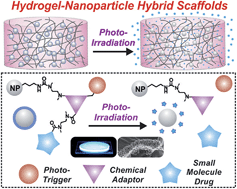Photo-triggerable hydrogel–nanoparticle hybrid scaffolds for remotely controlled drug delivery†
Abstract
Remotely-triggerable drug delivery systems enable the user to adjust dosing regimens on-demand based on a patient's physiological response and clinical needs. However, currently reported systems are limited by the non-specific leakage of drugs in the absence of triggering and the lack of repeatability over multiple cycles of release. To this end, we have designed a unique hydrogel–nanoparticle hybrid scaffold that provides a chemically-defined, remotely-triggerable and on-demand release of small molecule drugs. Our hybrid platform consists of three distinct components: (1) a photo-triggerable chemical compound, which serves to release a covalently-bound drug upon photo-irradiation, (2) a nanoparticle, which serves to covalently bind the photo-triggerable compound, and (3) a polymeric hydrogel, which serves to hold the drug-conjugated nanoparticle. Upon photo-irradiation, the activation of the photo-triggerable compound is designed to initiate a series of intramolecular chemical rearrangements, which would cleave the covalently-bound drug and release it from the hydrogel. The combination of these distinct components in a single scaffold proved to be an effective drug delivery system, as demonstrated by the delivery of a model drug to a malignant cancer line. Our hybrid scaffold can be easily tuned for practically any biological application of interest, thus offering immense potential for clinical therapies.


 Please wait while we load your content...
Please wait while we load your content...